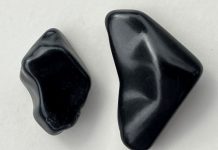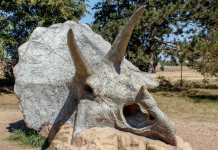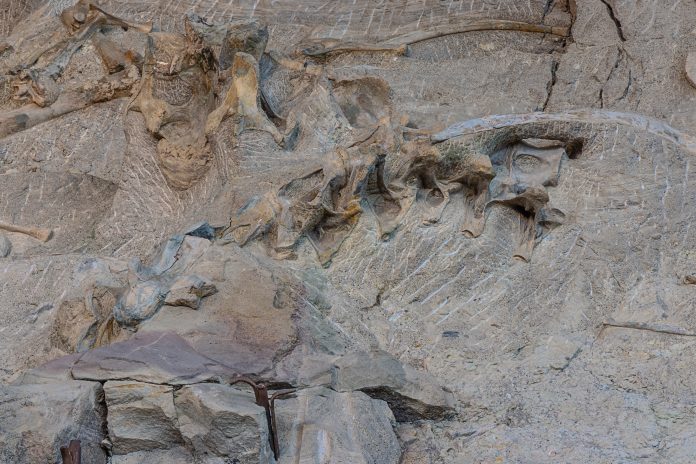
Our best national parks and monuments are a treasure trove for anyone interested in fossils and paleontology. They offer an opportunity to view rare insect and fish fossils, an abundance of petrified wood, a rock wall studded with 1,500 dinosaur bones, working fossil quarries and paleontological laboratories. Although most of the National Park Service’s 177 parks and monuments are involved with fossils in some manner, ten exist specifically to protect, preserve, study, and interpret paleontological resources.
These ten paleontology-oriented parks and monuments represent a huge span of geological time from the late Triassic Period 225 million years ago to the Pleistocene ice ages just 15,000 years ago. The fossils they display range from tiny insects to the bones of huge dinosaurs. The largest of these “paleontology parks” covers 379 square miles, the smallest just a few acres. The oldest dates to 1906; the newest was established in 2015.
Here’s a nutshell account of our paleontology-oriented best national parks and monuments.
Petrified Forest National Park
(www.nps.gov/pefo)
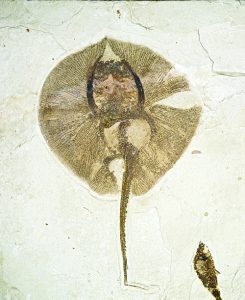
Perhaps the best-known of the paleontology-oriented parks and monuments, it covers 346 square miles in northeastern Arizona 26 miles east of Holbrook. Early pioneers were intrigued by its abundance of brightly colored, petrified logs. This area became a national monument in 1906 to protect its paleontological resources from commercialization and rampant collecting. Designated a national park in 1962, it now welcomes 660,000 visitors each year.
Petrified Forest is among the world’s top sources of Triassic Period fossils. Although famed for its iconic, multicolored fossil logs and bizarre badlands topography, the park also yields fossils of amphibians, predatory reptiles, and most importantly, the earliest-known dinosaurs. Recent fossil recoveries continue to provide new insight into dinosaur evolution during the Late Triassic Period, a time that paleontologists call the “dawn of the dinosaurs.”
The park’s bedrock consists of exposed sediments of the Chinle Formation, which were deposited between 216 and 205 million years ago by streams and rivers that flowed over plains and through low hills and swamps. Periodic flooding swept logs and animal carcasses onto sandbars, where they became buried and fossilized.
Paleontologists have identified more than 200 paleobotanical species through the study of leaf, stem, seed, frond, and cone fossils. Only a dozen of these are trees, the most common being Araucarioxylon arizonicum, a 180-foot-high conifer.
Petrified Forest National Park displays petrified wood at its two visitor centers. The outstanding paleontological exhibits at the Rainbow Forest Museum at the southern end of the park include full skeletal mounts of the Triassic dinosaurs, reptiles and amphibians that once roamed the area.
Fossil Butte National Monument
(www.nps.gov/fobu)
Located in southwestern Wyoming 15 miles west of Kemmerer, among the best national parks and monuments, this area protects part of the fossil-rich Fossil Butte Member of the Eocene Green River Formation. Established in 1972, Fossil Butte National Monument covers 13 square miles and hosts 20,000 visitors annually.
During the Eocene Epoch some 50 million years ago, this region was a subtropical-lake ecosystem. Fifty-mile-long Fossil Lake, the smallest of three fresh-water lakes, deposited fine-grained sediments that were a near-perfect host for the fossilization of detailed, articulated skeletons, particularly those of fish.
Today, Fossil Buttes is recognized as a world-class paleontological site. Fossil fish are by far its most abundant fossils and the 27 identified species include paddlefish, stingrays, gars, herrings, and perches, all preserved in great detail and as long as 20 inches. Also among this monument’s fossils are those of 10 mammal species, including bats and horse-like, lemur-like, and otter-like mammals; 15 species of reptiles; 30 species of birds; several species of arthropods and amphibians; and innumerable plant fossils. Many fossils are of life forms that are rarely preserved elsewhere.
The Fossil Butte Visitor Center displays more than 300 fossils and presents excellent video programs. It also provides an opportunity to observe an operating fossil-preparation laboratory and conducts summer programs in which visitors can help paleontologists excavate a fossil quarry (all fossils remain with the national monument’s scientific program).
Dinosaur National Monument
(www.nps.gov/dino)
Located in the northwest corner of Colorado and adjacent Utah, this site hosts 300,000 visitors each year. It became a national monument in 1915 with only 80 acres but has since been expanded to 312 square miles. In 1909, Carnegie Museum paleontologist Earl Douglass discovered a 150-million-year-old Morrison Formation stratum that is rich in dinosaur fossils. This stratum had once been a sandbar in a large Jurassic river where dinosaur carcasses had collected and become buried and fossilized. By 1923, paleontologists had recovered 350 tons of fossilized bones that were reassembled into 23 nearly complete skeletal mounts.
This monument’s main attraction is the recently rebuilt Quarry Exhibit Hall which houses the world-famous “Wall of Bones”—a partially excavated rock wall within the Carnegie Dinosaur Quarry with more than 1,500 exposed dinosaur bones. Visitors can also view full skeletal mounts of such large dinosaurs as the carnivore Allosaurus and the plant-eaters Diplodocus and Stegosaurus. The Carnegie Dinosaur Quarry has yielded 11 species of dinosaurs and excavations continue today. The monument’s most recently identified new dinosaur species, the large plant-eater Abydosaurus mcintoshi, was unearthed in 2010.
Florissant National Monument
(www.nps.gov/flfo)
This monument, located 35 miles west of Colorado Springs, Colorado, is the best national parks site premier source of 34-million-year-old plant and insect fossils from the late Eocene Epoch.
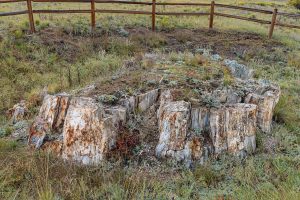
Since excavations began in the 1870s, its thinly laminated, fine-grained shale has yielded more than 50,000 museum-grade fossil specimens representing 1,700 plant and insect species.
Florissant Fossil Beds National Monument was created in 1969 to halt the commercialization and rampant collecting that was destroying this paleontological resource. Today, this is among the best national parks and monuments and hosts 60,000 visitors each year.
During the Eocene Epoch, Colorado had a warmer and wetter climate with plant systems similar to those that thrive today in subtropical, coastal lowlands.
Florissant was then the site of a shallow, 15-mile-long lake bordered by a dense forest that supported many aquatic and terrestrial life forms, along with dense populations of spiders and insects, the latter including dragonflies, cockroaches, aphids, flies, beetles, wasps, ants, and butterflies. Intensive nearby volcanism produced ashfalls and mudslides that buried and fossilized many of these life forms.
The Florissant Fossil Beds National Monument Visitor Center, rebuilt in 2013, displays hundreds of plant and insect fossils and has state-of-the-art, interactive exhibits. Near the Visitor Center is the “Trio,” a group of three massive, petrified sequoia stumps that originate from a common root system.
Hagerman Fossil Beds National Monument
(www.nps.gov/hafo)
This destination is located in southwestern Idaho 80 miles from Boise. The seven-square-mile monument, established in 1988, protects a rich deposit of late Pliocene Epoch fossils and the largest source of Hagerman horse (Equus simplicidens) fossils.
The Hagerman Horse, the earliest single-toed horse, evolved 3.5 million years ago. The monument’s Hagerman Horse Quarry has also yielded more than 200 species of flora and fauna that include fossils of mastodons, saber-toothed cats, bone-crushing dogs, fish, frogs, voles, and beaver, which collectively provide a superb glimpse of life prior to the great ice ages when modern flora and fauna first appeared.
The Hagerman sediments, which were deposited in a floodplain environment, are a continuous stratigraphic record spanning 500,000 years that represents such paleontological ecosystems as wetlands, grasslands, and grassy savanna. The excavations started by the Smithsonian Institution in the 1930s continue today.
Although no in situ fossils can be seen at Hagerman Fossil Beds National Monument, its visitor center displays hundreds of prepared fossils, including a full skeletal mount of a Hagerman horse. The monument hosts 26,000 visitors each year.
Agate Fossil Beds National Monument
(www.nps.gov/agfo)
Located near the western Nebraska town of Harrison, this monument was established in 1997 and named for the nearby Agate Springs Ranch. Hosting 15,000 visitors per year and covering 18 square miles, it is the best national parks fossil site for 20-million-year-old Miocene Epoch mammals. A densely packed, two-foot-thick bone bed has yielded fossils of Miohippus, the direct ancestor of the modern horse, and those of bear dogs, rhinoceroses, and camel-like mammals.

Among the monument’s most unusual trace fossils are “devil’s corkscrews,” well-defined, six-foot-high, corkscrew-shaped casts in sedimentary rock that are the fossilized burrows of Paleocastor, a forerunner of modern beavers. The Agate Fossil Beds National Monument Visitor Center has exhibits of fossils, casts, slabs (large masses of rock embedded with fossilized mammal bones), and murals depicting Miocene Epoch paleoenvironments. The monument’s four miles of trails pass historic bone quarries.
Tule Springs Fossil Beds National Monument
(www.nps.gov/tusk)
This noted monument among the best national parks is found near Las Vegas, Nevada. It was established in 2014 and covers 35 square miles. First excavated in 1933 by the American Museum of Natural History paleontologists, the site has yielded fossils of late Pleistocene Epoch Columbian mammoths, camels, ground sloths, dire wolves, horses, and North American cave lions that lived 12,000 years ago. The Columbian mammoth fossils include those of both adults and juveniles.
Once a lush, late Pleistocene wetland, Tule Springs is one of the world’s greatest assemblages of Ice Age fossils. It is the first place in the United States where paleontologists used radiometric dating to determine the age of fossils. In 1962, Nevada State Museum paleontologists conducted the “Big Dig,” excavating mile-long trenches that revealed thousands of additional bones. Some paleontologists expect future excavations to reveal evidence of contact between humans and late Ice Age mammals. The newly established Tule Springs National Monument does not yet have a visitor center, but trails with interpretive signs access excavations with visible, in situ fossils.
John Day Fossil Beds National Monument
(www.nps.gov/joda)
Consisting of the separate Sheep Rock, Painted Hills, and Clarno units, this national monument is located in east-central Oregon. Established in 1975, it covers 22 square miles and hosts 210,000 visitors per year. Its sedimentary strata contain well-preserved plant and animal fossils representing 40 million years of geologic time from the late Eocene Epoch 45 million years ago to the late Miocene Epoch 5 million years ago. This monument’s unusually lengthy sequence of burial and fossilization is due to repetitive events of volcanic ash and stream deposition of volcanic sediments.
In 2005, the monument opened its Thomas Condon Paleontology Center, a state-of-the-art facility named for the prominent 19th-century Oregon scientist who first collected the local fossils. Located in the Sheep Rock Unit near Dayville, Oregon, the center displays more than 500 fossils and offers video presentations, scientifically accurate murals depicting paleoenvironments, and viewing windows to observe activity in a fossil-preparation laboratory.
Badlands National Park
(www.nps.gov/badl)
Located in southwest South Dakota 80 miles southeast of Rapid City, this site hosts more than one million visitors per year and consistently tops the best national parks lists. The park’s three separate units cover 379 square miles of sharply eroded, brightly colored buttes, pinnacles, and gorges.

Badlands became a national monument in 1939 and a national park in 1978. Its profusion of fossils first attracted scientific and public attention in the 1870s.In 1899, the South Dakota School of Mines (now the South Dakota School of Mines & Technology) began paleontological investigations that continue today.
The park’s sediments contain both 75-million-year-old late Cretaceous Period marine fossils and 30-million-year-old Oligocene Epoch mammal fossils, the latter including those of rhinoceroses, horses, saber-toothed cats, and camels. National Park Service and South Dakota School of Mines & Technology paleontologists recently spent 15 summer seasons recovering 13,000 fossilized bones. Badland National Park’s Ben Reifel Visitor Center displays hundreds of fossils including several full skeletal mounts. Its Fossil Exhibit Trail passes several sites with visible, in situ bones.
Waco Mammoth National Monument
(www.nps.gov/waco)
This site was established in 2015 and is the most recent addition to the best national parks fossil-rich locations. In its first year, Waco Mammoth National Monument hosted nearly 70,000 visitors. Covering just five acres, it is also one of the smallest national monuments. Since an arrowhead collector discovered this Pleistocene Epoch fossil site in 1978, it has yielded 24 complete, fossilized skeletons of 68,000-year-old Columbian mammoths, including those of an adult-juvenile nursery herd.
The site opened in 2009 after a “Dig Shelter” was built to protect the in-situ bones. Waco Mammoth National Monument is jointly operated by the National Park Service, the city of Waco, and Baylor University. Visitors may take guided tours into the Dig Shelter to view in situ bones. Prepared fossils are exhibited at the Mayborn Museum Complex on the nearby Baylor University campus.
Best National Parks Bring Paleontology Alive For Juniors
All these paleontology-focused best national parks and monuments participate in the Junior Paleontologist Program, a part of the National Park Service’s popular Junior Ranger Program. Its goal is to develop awareness among young people, primarily ages 6 to 12, of their national parks and monuments and of the paleontological resources that they protect. The Junior Paleontologist Program offers ranger-led outings, special activities, and educational materials that explain the geologic history, how fossils are formed and preserved, and how paleontologists excavate, study and interpret fossils. Those who complete the lessons and activities earn the National Park Service’s Junior Paleontologist badge.
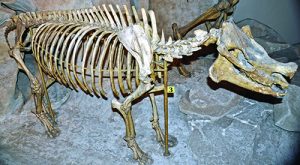
The National Park Service’s National Fossil Day is celebrated each October during Earth Sciences Week. National Fossil Day is designed to promote public awareness and stewardship of fossils, foster a greater appreciation of their scientific and educational value, and to explain the National Park Service’s involvement with fossils. It includes ranger-led discussions, tours to selected paleontological sites, and hands-on fossil-excavation activities.
Many paleontology-oriented national parks and monuments have volunteer opportunities for adult Paleontology Assistants. Applicants should possess hands-on skills in working with fragile, irreplaceable fossils and some experience in the basic paleontological fields and laboratory methods. Paleontology Assistants work in a variety of jobs, including assisting in field excavations and laboratory fossil preparation.
South Dakota’s ‘Ghost’ Monument
One other paleontology-oriented national monument should be mentioned, the Fossil Cycad National Monument. If this name is not familiar, it is because Fossil Cycad is a “ghost” monument that no longer exists. It once included the site of a remarkable deposit of 120-million-year-old cycad fossils near Edgemont in southwestern South Dakota. Cycads are tree-sized plants related to ferns. With their unique branching and reproductive systems, these Cretaceous Period cycads help paleontologists to understand the evolution of flowering plants. After the site was discovered in 1892, it quickly attracted hordes of both private and commercial collectors.
In 1922, a Yale paleobotanist, concerned with the rampant, non-scientific collecting of the fossils, personally homesteaded the land to protect it. Two years later, he turned the half-square-mile property over to the National Park Service which designated it a national monument. But because its supervision was assigned to Wind Cave National Park 20 miles away, the new monument had no direct protection and the now-illegal fossil collecting continued.
By 1935, all visible fossils had been destroyed or removed. In 1957, Fossil Cycad was delisted as a national monument and turned over to the Bureau of Land Management. But today, the experience with the former Fossil Cycad National Monument is serving as a lesson. Its cycad fossils are now part of a traveling exhibition making the rounds to the best national parks and monuments to illustrate the need to protect the nation’s paleontological resources.
When visiting our paleontology-oriented best national parks and monuments, always remember that unauthorized collection of fossils or any other materials is prohibited.
For additional information on the Junior Paleontologist Program and National Fossil Day, visit www.nps.gov.
This story about the best national parks for paleontology and fossils previously appeared in Rock & Gem magazine. Click here to subscribe. Story by Steve Voynick.




